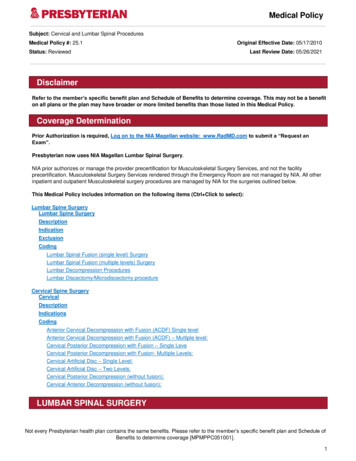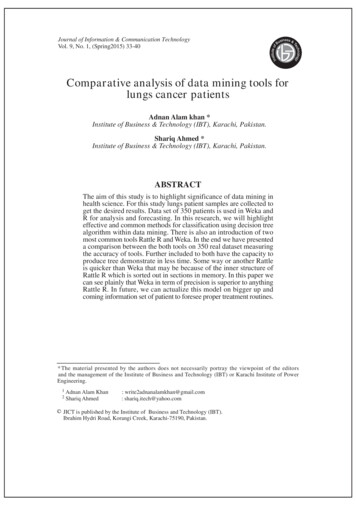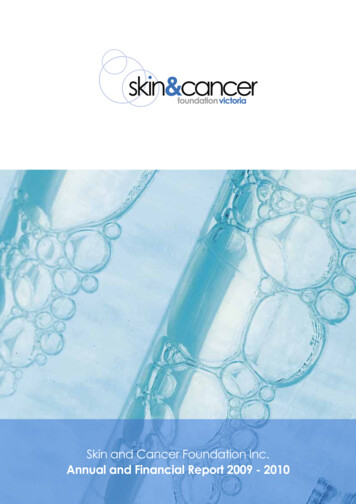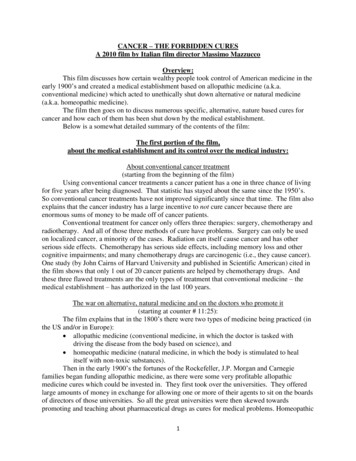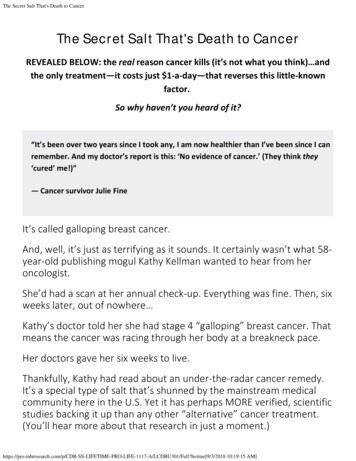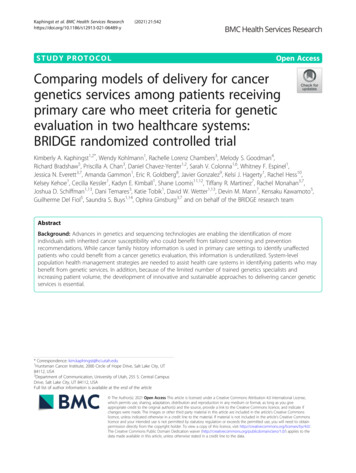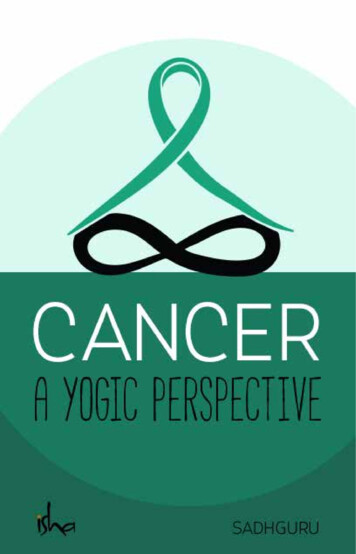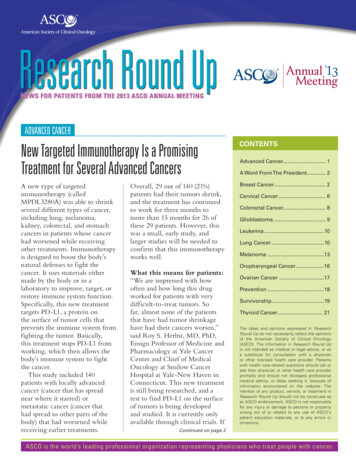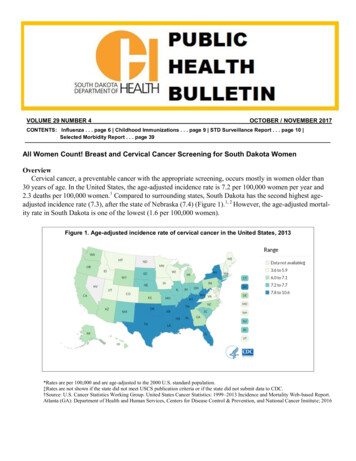
Transcription
VOLUME 29 NUMBER 4OCTOBER / NOVEMBER 2017CONTENTS: Influenza . . . page 6 Childhood Immunizations . . . page 9 STD Surveillance Report . . . page 10 Selected Morbidity Report . . . page 39All Women Count! Breast and Cervical Cancer Screening for South Dakota WomenOverviewCervical cancer, a preventable cancer with the appropriate screening, occurs mostly in women older than30 years of age. In the United States, the age-adjusted incidence rate is 7.2 per 100,000 women per year and2.3 deaths per 100,000 women.1 Compared to surrounding states, South Dakota has the second highest ageadjusted incidence rate (7.3), after the state of Nebraska (7.4) (Figure 1).1, 2 However, the age-adjusted mortality rate in South Dakota is one of the lowest (1.6 per 100,000 women).Figure 1. Age-adjusted incidence rate of cervical cancer in the United States, 2013*Rates are per 100,000 and are age-adjusted to the 2000 U.S. standard population.‡Rates are not shown if the state did not meet USCS publication criteria or if the state did not submit data to CDC.†Source: U.S. Cancer Statistics Working Group. United States Cancer Statistics: 1999–2013 Incidence and Mortality Web-based Report.Atlanta (GA): Department of Health and Human Services, Centers for Disease Control & Prevention, and National Cancer Institute; 2016
In 1991, the Centers for Disease Control and Prevention (CDC) established the National Breast and Cervical Cancer Early Detection Program (NBCCEDP) as part of an effort to support low income women in completing the recommended screening schedule for breast and cervical cancer.3 The NBCCEDP delivers screening and diagnostic services to low income, uninsured, or underinsured women. In South Dakota, the All Women Count! (AWC!) Program is part of the national program funded through CDC since 1997. The AWC! Program works with 230 provider sites across South Dakota.4According to the US Preventive Services Task Force (USPSTF), women ages 21 to 65 should be screenedregularly for cervical cancer.5 The standard screening method is the Pap test (cytology) and the results are categorized using the Bethesda system. The most recent recommendation by the USPSTF for cervical cancerscreening is a Pap test every three years among women who have had three normal Pap tests within the lastfive years. However, the screening frequency may be less if a human papillomavirus (HPV) test is performedalong with a Pap test, also called HPV co-testing. HPV is a common virus and two HPV types (16 and 18) areassociated with 70% of cervical cancers and pre-cancerous cervical lesions. Hence, the USPSTF recommendsthe HPV co-test every five years for women ages 30-65 that have had negative HPV and normal Pap test results. Finally, cervical screening is not recommended for women aged 65 and older with low risk for cervicalcancer or with previous cervical screening results that were normal. In addition, it is important to mention thatCDC also recommends two doses of HPV vaccine for 11- to 12-year-olds to prevent cervical cancer and othercancers caused by HPV.6Eligibility CriteriaCervical cancer screening and diagnostic services are available through the AWC! Program for women whomeet the eligibility criteria. The services provided by the AWC! Program for cervical cancer screening includePap tests and HPV co-tests. To be eligible, women must be: 1) below or at 200% of federal poverty level, 2)uninsured or underinsured which is defined as those who cannot afford the copayments or deductibles orwhose insurance does not cover breast or cervical cancer screening services, and 3) between the ages of 30 and64 years.Sociodemographic of AWC! ParticipantsFrom 2001-2015, the AWC! Program served 17,794 women in South Dakota. Among AWC! participantswhose information on previous screening was available, 1,817 (13%) had rarely or never been screened (lastscreen 5 years). The race and ethnicity distribution of women screened and served in the AWC! Program isshown in Figure 2. The majority of women screened were white (71%), 17% were American Indian, followedby Hispanics (8%), and other/unknown (4%) (e.g., Asian and Black/African American).According to the data shown in Figure 3, 52% of the AWC! participants reported having some college orhigher degree as their highest level of education. Women with a high school degree accounted for 31%, followed by some high school or less (17%).South Dakota Public Health Bulletin — October/November 2017 — Page 2
Figure 2Racial/ethnicity distribution (%) of womenreceiving AWC! cervical service, 2001-2015Hispanic8%Other/Unknown4%Figure 3Education level distribution (%) of womenreceiving AWC! cervical service, 2001-201560%52%50%40%American Indian17%31%30%17%20%10%White71%0%Some high school or less High school or equivalent Some college or higherAWC! Cervical ScreeningsFigure 4 shows trends in the number of cervical cancer screening services (Pap test and HPV co-test) received by women in All Women Count!. From 2001 to 2009, an increase in the number of Pap tests was observed; an increase in the number of HPV co-tests was seen from 2012-2015. A steady decrease in the numberof Pap tests occurred from 2012-2015. This may be due to changes in cervical cancer screening guidelines in2009 (introduction of HPV testing) and in 2012 (USPSTF screening guideline change).Figure 4Number of cervical screenings (Pap test and HPV testing) provided through AWC!, 2001-2015Beginning ofHPV 2001 2002 2003 2004 2005 2006 2007 2008 2009 2010 2011 2012 2013 2014 2015Pap testHPV testSouth Dakota Public Health Bulletin — October/November 2017 — Page 3
AWC! Cervical Results and DiagnosisFrom 2001-2015, the AWC! Program provided 33,650 Pap tests. Over this period, the percentage of womenwith an abnormal Pap test was 8.5% (Table 1). An abnormal Pap test includes low-grade squamous intraepithelial lesion (LSIL), high-grade squamous intraepithelial lesion (HSIL), atypical squamous cells of undeterminedsignificance - cannot exclude HSIL (ASC-H), atypical glandular cells (AGC), and squamous cell cancer.Table 1. Pap test results among women receiving screening services through the AWC! Program, 2001 - 2015Pap Test Results (2001-2015)Negative for intraepithelial lesion or malignancy (NIL)Atypical squamous cells of undetermined significance (ASC-US)Low-grade squamous intraepithelial lesion (LSIL)(including HPV/mild dysplasia/CINI)Atypical squamous cells cannot exclude HSIL (ASC-H)High-grade squamous intraepithelial lesion (HSIL)Squamous cell carcinomaAtypical glandular cells (including Atypical, EndocervicalAdenocarcinoma in situ, and Adenocarcinoma)Other/result pending/unsatisfactory/unknownTotal Pap test provided (2001-2015)Total number of abnormal als include Pap test results of: low-grade squamous intraepithelial lesion (LSIL), high-grade squamous intraepithelial lesion (HSIL),atypical squamous cells of undetermined significance - cannot exclude HSIL (ASC-H), atypical glandular cells (AGC), and squamous cell cancer.According to the data shown on Table 2, 388 women who had an HPV co-test were positive for HPV. In addition, 146 women who were diagnosed with a pre-malignant cancer were also HPV positive on the HPV cotesting. Of the women that have had an HPV co-test through the AWC! Program since 2009, 42% were under40, 32% were 40-49 years old, and 26% were 50-64 years old.Table 2. HPV results among women served through the AWC! Program, 2009 - 2015HPV test (2009-2015)Total number of HPV testsHPV HPV HPV and abnormal Pap testHPV and cervical pre malignant cancerHPV and cervical cancer (malignant and in situ)Number1,3971,0093883121465Note. HPV results are not mutually exclusive.Table 3 provides the number of cervical cancers detected. Among the 1,493 diagnostic tests provided, 31%were CINI/Mild dysplasia, followed by CINIII (15%), and CINII (11%).Table 3. Diagnostic results among women served through the AWC! Program, 2001 - 2015Final Diagnosis ta/AtypiaCINI/Mild dysplasia (biopsy diagnosis)CINII/Moderate dysplasia (biopsy diagnosis)CINIII/Severe dysplasia/Carcinoma in situ (stage 0) orAdenocarcinoma In Situ of the cervix (AIS) (biopsy diagnosis)Invasive cervical carcinoma (biopsy 37.81.431.010.615.240191,4932.71.3100South Dakota Public Health Bulletin — October/November 2017 — Page 4
Since 2004, the AWC! Program has linked the cases of cancer the program has detected with the South Dakota Cancer Registry. Figure 5 shows trends in the number of cervical cancers detected through the AWC! Program from 2004 to 2015. The highest number of cancers diagnosed was in 2011, with a considerable decreaseobserved in the following years (2012 to 2015).Figure 5Number of cervical cancers diagnosed among AWC! participants, 2004 - 2015 (N 34)ConclusionThe AWC! Program, which strives to reach and screen low-income, uninsured, and underinsured women inSD, has served nearly 18,000 women and provided 33,650 Pap tests, 1,397 HPV co-tests, and 1,493 diagnostictests from 2001-2015 combined. Moreover, 34 cervical cancers were diagnosed from 2004-2015. The AWC!Program has the capacity to screen more women for cervical cancer. In order to find women eligible for cervical cancer screening and the AWC! Program, clinicians are encouraged to utilize electronic medical records(EMR) to implement provider and client reminders to increase cervical cancer screening.7 Early diagnosis ofcervical cancer improves survival rates and reduces mortality rates.3 Continued efforts targeting the underserved population in South Dakota is a priority of the AWC! Program.References1. U.S. Cancer Statistics Working Group. United States Cancer Statistics: 1999–2013 Incidence and Mortality. Web-based ReportAtlanta: U.S. Department of Health and Human Services, Centers for Disease Control and Prevention and National Cancer Institute; 2016 [Available at https://nccd.cdc.gov/uscs/].2. South Dakota Cancer Registry. An Annual Report on Cancer Incidence and Mortality Among South Dakotans, 2013. South Dakota Department of Health, 2016.3. CDC. National Breast and Cervical Cancer Early Detection Program (NBCCEDP) 2016 [Available at http://www.cdc.gov/cancer/nbccedp/about.htm].4. South Dakota Department of Health. All Women Count! 2016 [Available at https://getscreened.sd.gov/count/].5. CDC. Cervical Cancer Screening Guidelines for Average-Risk Women. 2016. Screening. [Available at .pdf].6. CDC. Human Papillomavirus (HPV). [Available at https://www.cdc.gov/hpv/].7. The Community Guide. [Available at eening].Authors: Patricia Da Rosa, Public Health Data Analyst, College of Nursing, SDSUAshley Miller, Chronic Disease Epidemiologist, SD Department of HealthKaren Cudmore, Cancer Programs Director, SD Department of HealthSouth Dakota Public Health Bulletin — October/November 2017 — Page 5
INFLUENZA: The 2016-2017 Flu Season in South Dakota and the United StatesNational Influenza Surveillance DataDuring the 2016-17 season, influenza activity was moderate. The season was notable for the predominantcirculation of influenza A (H3N2) viruses. Nationally, influenza activity peaked in mid-February, with influenza A (H3N2) viruses predominate early in the season through the week ending March 25, 2017 (week 12).Influenza B viruses became the predominant virus starting during week 13 (the week ending April 1, 2017)and remained the predominant virus through the end of May. The timing of peak influenza activity variedacross the United States. Influenza activity peaked at least one month earlier (week 52 to week 2) in the western states than in the rest of the country. During the 2016-17 season, severity indicators (e.g., hospitalizationand mortality rates) were within the range that has been observed during previous seasons when influenza A(H3N2) viruses predominated. Previous influenza A(H3N2) predominant seasons have been associated withincreased hospitalizations and deaths compared with A(H1N1) predominant, especially among children aged 5 years and adults aged 65 years. The majority of influenza viruses antigenically characterized at CDCwere similar to the reference viruses representing the recommended components for the 2016-17 vaccine. Asmall subset of antigenically distinct influenza B/Victoria viruses was detected. No antiviral resistance tooseltamivir, zanamivir, or peramivir was identified among tested influenza viruses from the 2016-17 season.Final vaccine effectiveness estimates of 34% (95% CI 24%-42%) against illness caused by influenza A(H3N2) viruses and 56% (95% CI 47%-64%) against illness caused by influenza B viruses were similar toprevious seasons when recommended vaccine viruses have been well-matched to (i.e., “like”) circulating viruses, including the lower effectiveness observed against well-matched A(H3N2) viruses. Evidence of reduced protection against A(H3N2) viruses, even when vaccine viruses and circulating viruses are wellmatched, has been observed since the 2011-12 season. In general, vaccination with inactivated influenza vaccine has offered better protection against influenza A(H1N1) and influenza B viruses. Even during seasonswhen vaccine effectiveness is reduced, vaccination can offer substantial benefit and reduce the likelihood ofsevere outcomes such as hospitalization and death. During the 2012-13 season with estimated vaccination effectiveness against A(H3N2) related illness of 39% (95% CI 39-47%), vaccination averted an estimated 5.6million illnesses, 2.7 million medical visits, 61,500 hospitalizations, and 1,800 deaths.Influenza antiviral medications are an important adjunct to vaccination in the treatment and prevention ofinfluenza. Treatment with influenza antiviral medications as close to the onset of illness as possible is recommended for patients with confirmed or suspected influenza who have severe, complicated, or progressive illness; who require hospitalization; or who are at high rate for influenza complications. Antiviral treatmentshould not be withheld from patients who are high risk for complications or who are severely ill with suspected influenza infection, even if rapid antigen – detection influenza diagnostic test results are negative.Although summer influenza activity in the United States typically is low, influenza cases and outbreakshave occurred during summer months and clinicians should remain vigilant in considering influenza in thedifferential diagnosis of summer respiratory illnesses. Testing for seasonal influenza viruses and monitoringfor novel influenza A virus infections should continue year-round. Health care providers also are reminded toconsider novel influenza virus infections in persons with influenza-like illness and swine or poultry exposure,or with severe acute respiratory infection after travel to areas where avian influenza viruses have been detected. Providers should alert the local public health department if novel influenza virus infection is suspected.Clinical laboratories using a commercially available influenza diagnostic assay that includes influenza A virussubtype determination should contact their state public health laboratory to facilitate, transport, and additionaltesting of any specimen that is positive for influenza A, but for which the subtype cannot be determined. Public health laboratories should immediately send influenza A virus specimens that they cannot subtype usingstandard methods to CDC and submit all specimens that are otherwise unusual as soon as possible after identification.Ref: MMWR/June 20, 2017/Vol.66/No 25South Dakota Public Health Bulletin — October/November 2017 — Page 6
South Dakota Influenza Epidemiology and Laboratory SurveillanceThe South Dakota Department of Health (SDDOH) and SD Public Health Laboratory (SDPHL) conductsurveillance for influenza year-round and enhanced surveillance October through May. The components ofSouth Dakota’s influenza surveillance program for the 2016-17 season included 63 laboratory sentinel sites;40 Influenza Like Illness Network (ILINet) providers; viral culture, PCR, and DFA testing for confirmatorytesting; reporting of aggregate rapid antigen results; influenza associated hospitalizations and deaths; and institutional outbreaks. During the influenza season, weekly summary reports are posted on the SDDOH website at http://doh.sd.gov/flu.During the 2016-17 flu season, there were 2,070 confirmed influenza cases reported to SDDOH: A(H3N2)837 (40%), A(H1N1) 20 (1%), A-not subtyped 537 (26%), and 675 (33%) influenza B. Additionally, 74,720rapid antigen influenza tests were accomplished with 16,397 positive (22%) – 10,614 (14%) positive for influenza A and 5,783 (8%) positive for influenza B. The 2016-17 influenza viruses had a substantial impact on allage groups. The median ageSouth Dakota seasonal distribution of influenza by MMWR weekof confirmed cases was 41years with an age range ofone week to 105 years.The first confirmed caseof influenza was reportedthe first week of October2016 and the last case reported late August 2017.The peak of the season wasthe third week in February2017, with A(H1N1), A(H3N2), and Influenza Bviruses all circulating at thesame time.Forty-three individuals died due to influenza and its complications during the 2016-17 season. Genderbreakdown was 53% female and 47% male. The median age was 88 years with an age range of 32 years to105 years. Seventy-nine percent of the influenza associated deaths were White, 16% were unknown, and 5%were Native American.There were 960 hospitalizations reported during the2016-17 influenza season. This was the most influenzaassociated hospitalizations in South Dakota ever reported.The first hospitalization was identified in the first week ofOctober 2016 and the last was reported late August 2017.Hospitalizations peaked in the third week of February.For patients who were hospitalized with influenza, theage range was one week to 100 years with a median ageof 71 years.South Dakota distribution of influenzahospitalizations & deaths by ageLab ConfirmedInfluenza Cases(by DFA, PCR, or sInfluenzaAssociatedDeaths# Hosp(%)# Deaths(%)# 87(19%)94(10%)2 (5%)50-64289(14%)171(18%)3 (7%) 64680(33%)591(62%)38 (88%)0Other viral respiratory pathogen reports included 183Total207096043Adenovirus, 271 Corona Virus OC43, 135 Corona Virus229E, 4 Chlamydiophila Pneumonia, 30 Human Metapneumo Virus, 522 Parainfluenza-1, 180 Parainfluenza2, 6 Parainfluenza-3, 53 Parainfluenza-4, 259 Respiratory Syncytial Virus, and 918 Rhino/Enterovirus.Author: Vickie Horan, Influenza Surveillance Coordinator, SD Department of HealthSouth Dakota Public Health Bulletin — October/November 2017 — Page 7
Prevention and Control of Seasonal Influenza with Vaccines: Recommendations of theAdvisory Committee on Immunization Practices — United States, 2017–18 Influenza SeasonMMWR Recommendations and Reports / August 25, 2017 / 66(2);1-20SummaryThis report updates the 2016–17 recommendations of the Advisory Committee on Immunization Practices(ACIP) regarding the use of seasonal influenza vaccines (MMWR Recomm Rep 2016;65[No. RR-5]). Routineannual influenza vaccination is recommended for all persons aged 6 months who do not have contraindications. A licensed, recommended, and age-appropriate vaccine should be used.For the 2017–18 season, quadrivalent and trivalent influenza vaccines will be available. Inactivated influenza vaccines (IIVs) will be available in trivalent (IIV3) and quadrivalent (IIV4) formulations. Recombinantinfluenza vaccine (RIV) will be available in tri
Since 2004, the AWC! Program has linked the cases of cancer the program has detected with the South Da-kota Cancer Registry. Figure 5 shows trends in the number of cervical cancers detected through the AWC! Pro-gram from 2004 to 2015. The highest number of ca
